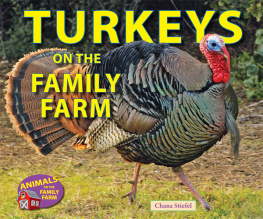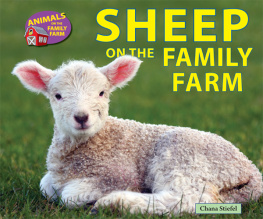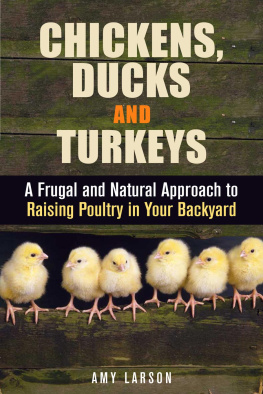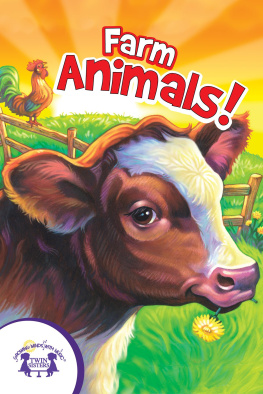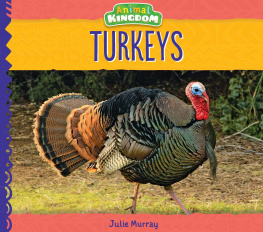Gobble, Gobble!
WELCOME TO THE FAMILY FARM! TURKEYS ARE ONE ANIMAL THAT LIVES ON THE FARM. HOW DO THE FARMERS RAISE THEM? FOLLOW THE FAMILY AT HOWLING WOLF FARM AS THEY SHOW THE IMPORTANT STEPS IN RAISING HEALTHY ANIMALS AND HEALTHY FOOD FOR THE PEOPLE IN THEIR COMMUNITY.
ABOUT THE AUTHOR
CHANA STIEFEL has a Masters Degree in Journalism from New York University and has written a wide variety of childrens books. While interviewing the family from Howling Wolf Farm, she enjoyed learning many new things about their farm animals and the hard work it takes to make healthy food.
coopA safe place for turkeys.
flockA group of turkeys.
henA female turkey.
jakeA young male turkey.
poultA baby turkey.
tomA male turkey.

Image Credit: Shutterstock.com

Image Credit: Shutterstock.com
Did you know that a turkey can see 100 yards away? Thats the length of a football field! Find out more fun facts about turkeys on the family farm.

Image Credit: Howling Wolf Farm
Tara, Matt, Jack and young Alice are ready for the day.
Up to 100 turkeys live on Matt and Taras farm. The family raises many other animals, too. Their children, Jack and Alice, help with the chores.

Image Credit: WILDLIFE GmbH/Alamy
Name game: A male turkey is called a tom or gobbler. A female is a hen. Baby turkeys are called poults. Young male turkeys are jakes. A group of turkeys is a flock.

Image Credit: Photos.com: fdevalera
A turkeys sharp nails help it dig up food.
During the day, the flock runs around outside. They eat grass and plants. Turkeys feet have sharp nails for digging. They dig up acorns, nuts, and seeds. Turkeys even find worms and bugs to eat! They drink water.

Image Credit: Howling Wolf Farm
The farmers check on the turkeys every day. If one gets sick, Matt will take it away from the flock. He may change its food. He may give it a healing plant to eat.

Image Credit: Sarah Kennedy
Young turkeys live inside a fence. It protects them from hungry animals, like foxes.
At night, the turkeys nest inside a coop. The coop looks like a big tent. It rests on wheels. Jack helps roll the coop down the field each day. This way, the turkeys always have fresh grass to eat.

Image Credit: Gould Academy/Tracey Wilkerson
The farmers roll the coop to a new spot every day.

Image Credit: Shutterstock.com
A tom turkey looks different from a hen. A toms head has more lumpy parts. When a tom gets excited, these parts fill with blood. They turn red.

Image Credit: Shutterstock.com

Image Credit: Shutterstock.com
A toms feathers are more colorful than a hens feathers. Its tail feathers spread open. They look like a fan. The fan makes the tom look bigger and stronger. Toms shake their feathers to make hens notice them.

Image Credit: Roger Tidman/FLPA/Minden Pictures
Toms strut around and display their fans so hens will spot them.

Image Credit: Shutterstock.com
Poults are kept warm in the barn. The farmers move the turkeys to the coop when they are seven or eight weeks old.
Baby turkeys are poults. They are bigger than baby chicks. Their necks are longer, too. Poults eat grass and bugs. Matt and Tara also feed them grain, dried fish meal, seaweed, and hard-boiled eggs. Alice helps feed the baby turkeys.

Image Credit: Shutterstock.com

Image Credit: Shutterstock.com
Matt and Taras biggest holiday turkey weighed 34 pounds.
The turkeys are raised for meat. People come to the farm to buy fresh turkey for their holiday dinners. The turkeys may weigh 8 to 25 pounds.

Image Credit: Howling Wolf Farm
Matt, Tara, and Alice sell the vegetables they grow, too.
Not all turkeys are the same. Turkeys have many breeds. See how different they look? Which one is your favorite?

Image Credit: Shutterstock.com
Naragansett

Image Credit: Shutterstock.com
Bronze Broad-Breasted


